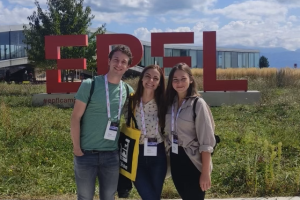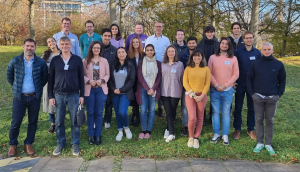ESRs attend Single-Molecule Localization Microscopy Symposium at EPFL in Switzerland.

In August 2021, the single-molecule localization microscopy symposium (SMLMS) took place at EPFL in Lausanne, Switzerland. The 3-day conference, organized by Suliana Manley and Aleksandra Radenovic, covered everything localization microscopy related, which is at the core of most research in work package 1 of SuperCol. This hybrid event was attended by 6 of our ESRs, either physically in Lausanne or online via Zoom. For some of us, this was the first physical conference, and it was experienced as a very interesting small-scale conference that allowed for a lot of networking and interaction with well-renowned speakers. Hopefully, a bigger group of ESRs can attend this interesting conference at the next SMLMS in Paris, in August 2022!
Aleksandra presented her results on the Trends in Nanotechnology International Conference in Albania!

At the beginning of October Aleksandra had a chance to present her results and represent our SuperCol team in person at TNT2021, the Trends in NanoTechnology 2021 conference!
It was a 5-days intense event in Tirana which covered a broad range of a current research in Nanoscience and Nanotechnology. In her presentations Aleksandra demonstrated how to control the position and the orientation of the single fluorescent dye using DNA origami technique. It was a great opportunity to spread the good news among workers in Nanoscience field!
Dynamic DNA sandwich biosensor using plasmonic nanorods
Particle based biosensors make use of different approaches to estimate target concentration. Here, we take advantage of the fluoresce enhancement provided by plasmonic particles to track single molecule specific interaction on functionalized gold nanorods. A DNA sandwich assay is designed to create specific interaction between particle, target and imager. Fluorophores close to plasmonic particle give high fluorescence signal, recorded in optical microscopy. The binding dynamic allows to determine the target concentration continuously in solution.
Meeting in Mainz marks next phase of SuperCol

SuperCol is the synonym for a challenging research project. Colloids, which are extremely small particles in the nanometer range, are to be investigated with the help of novel, high-resolution microscopy techniques, thus opening up new areas of application, such as nanomedicine or surface coatings. Now, even though the pandemic situation continues to play tricks on the SuperCol project, the first physical meeting could be held. On November 8th-11th, the Max Planck Institute for Polymer Research MPIP hosted the workshop ‘Colloidal synthesis and colloid characterization’ that proved to be very beneficial for hands-on learning and establishing personal connections. All project partners are now looking forward to the exciting new results that are expected from the fusion of expertise.
Meeting in Mainz marks next phase of SuperCol

SuperCol is the synonym for a challenging research project. Colloids, which are extremely small particles in the nanometer range, are to be investigated with the help of novel, high-resolution microscopy techniques, thus opening up new areas of application, such as nanomedicine or surface coatings. Now, even though the pandemic situation continues to play tricks on the SuperCol project, the first physical meeting could be held. On November 8th-11th, the Max Planck Institute for Polymer Research MPIP hosted the workshop ‘Colloidal synthesis and colloid characterization’ that proved to be very beneficial for hands-on learning and establishing personal connections. All project partners are now looking forward to the exciting new results that are expected from the fusion of expertise.
ABOUT THE SUPERCOL PROJECT
The SuperCol ITN project is taking a closer look at colloidal surfaces both visually and with receptor chemistry in order to aid development of these particle systems. To this end the project will combine super-resolution microscopy, colloidal sciences, and advanced modelling to (a) control, (b) visualize and quantify, and (c) rationally design surface-functionality to advance particle-based biomedical applications.
SuperCol establishes a unique and well-structured training network with leading R&D labs from European universities and industry in the domain of correlative microscopy and colloidal sciences. The 15 Early Stage Researchers (ESRs) will form a research team that is embedded in leading industrial and academic R&D labs. This will bridge the gap between the various disciplines by uniting their research efforts to solve the challenges.
